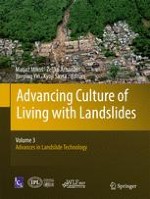2017 | OriginalPaper | Buchkapitel
Prediction of the Process of a Slowly Moving Loess Landslide by Electrical Resistivity Tomography
verfasst von : Sándor Szalai, Ernő Prácser, Kitti Szokoli, Ádám Tóth
Erschienen in: Advancing Culture of Living with Landslides
Aktivieren Sie unsere intelligente Suche, um passende Fachinhalte oder Patente zu finden.
Wählen Sie Textabschnitte aus um mit Künstlicher Intelligenz passenden Patente zu finden. powered by
Markieren Sie Textabschnitte, um KI-gestützt weitere passende Inhalte zu finden. powered by
